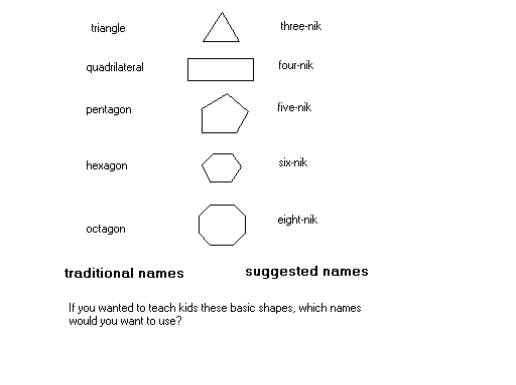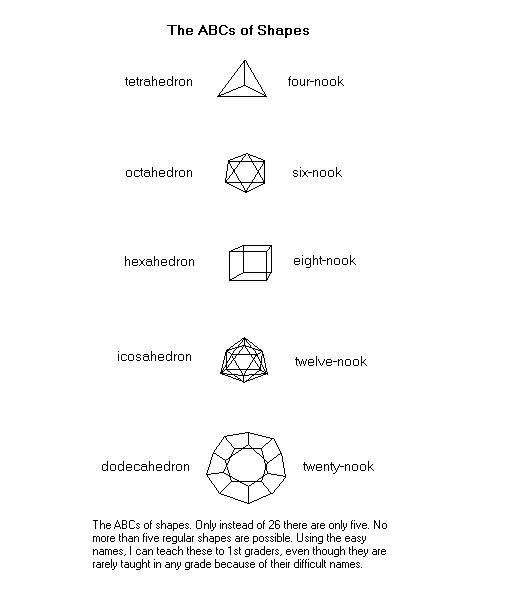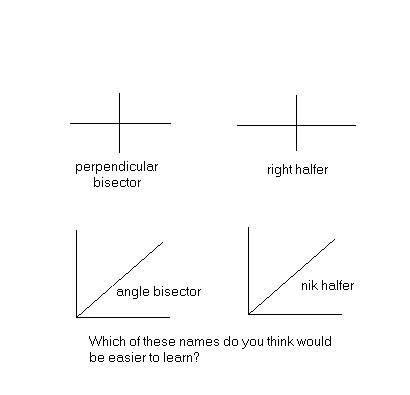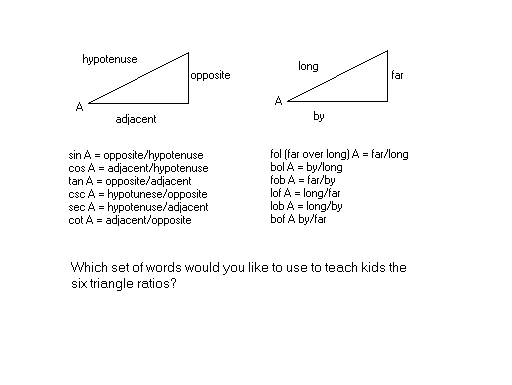SpeakEasy Math: Part I
by Bill Lauritzen
User-Friendly, Student-Centered Math: Mathematics in the Common Tongue
“In signs, one sees an advantage for discovery that is greatest when they express the exact nature of a thing briefly and, as it were, picture it; then indeed, the labor of thought is greatly reduced.” G. Leibniz
The Math Emperor has No Clothes
The problem in United States mathematical education is not that our kids are less intelligent than kids in other countries, or that our teachers are less talented, or that our educational techniques are less advanced. The problem is that our kids have to struggle to learn complex Latin and Greek nomenclature. In most other countries, using their languages, this intermediate learning step is completely non-existent.
For example, when we look at the Asian languages we see a counting system that is much more regular. The equivalent count in English would be: one, two, three, four, five, six, seven, eight, nine, ten, ten one, ten two, ten three…two ten, two ten one, two ten two, two ten three…etc. In the book Number Sense, we find studies showing that kids counting with this system learn much faster than American kids.
I call this the Easy Count. It may not be easier to say (in English), but it probably is a lot easier to learn. Kids in grades K-2 could learn to count using the Easy Count, and then when they had mastered the underlying principles of the number system, they could adopt the Traditional Count. In fact, since they would be hearing the Traditional Count much of the time on TV and radio, etc. they would probably be able to learn it without any formal schooling.
| triangle = sam kak quadrilateral = sah kak pentagon = oh kak hexagon = yuk ka |
| 1 | il |
| 2 | e long e |
| 3 | sam |
| 4 | sah |
| 5 | oh |
| 6 | yuk |
| 7 | chil |
| 8 | pal |
| 9 | koo |
| 10 | ship |
| 11 | ship il |
| 12 | ship e |
| 20 | e ship |
| 21 | e ship il |
| 30 | sam ship |
| 100 | baek |
| 200 | e baek |
Another example of the intermediate learning step in the U.S. occurs with our nomenclature for polygons (many angles) polyhedra (many faces).
For example, in Korean “3” is said “sam” and “4” is said “sah.” There triangle is called, “sam kak” or “three angles” and their quadrilateral is called “sah kak” or “four angles,” etc. U.S. kids have to learn “hexagon” instead of simply “six angles.” Thus they have to learn nomenclature as well as the shape. So while kids in other countries are learning the math (the spacial relationships between various shapes and angles, etc.) U.S. kids are still back at the starting gate, struggling with words like penta, hexa, dodeca, icosa, etc.
Education in the Common Tongue
I once gave a class of 9th graders a question that read: “Describe pi in your own words.” I was amazed at what they wrote. Most of them thought that the essential thing about pi was that it “went on and on and never stopped.” Most did not mention either diameter or circumference.
You might recall the fact from mathematics that pi is equal to the circumference of a circle divided by the diameter. Perhaps you have never had any use for this fact. Or perhaps you didn't care to remember it, as it brought back painful memories of school, tests, and quizzes. Or perhaps you never learned it at all.
Instead, what if I drew a circle and said that the "around" of the circle (showing you what I meant by "around") divided by the "across" of the circle (showing you what I meant by "across") were the same for any circle. And that we called this number pi. You might find this fact a lot more palatable.
In fact, I taught mathematics for many years to many different students, and I found that "around" divided by "across" communicates the concept of pi much easier and better.
That is because the words "around" and "across" are from what I call our common tongue. I have found that you can teach science, history, English, in fact, every subject in the common tongue, and with better results. The common tongue is the language we spoke as children. "Circumference" and "diameter" are from Latin and are not normally used by children in their everyday play activities. They don't say, "I put the belt on the circumference of my waist." They don't say, "I threw the ball the diameter of the circle." They use "around" and "across." Even thought "around" and "across" don't have exact meanings for the circle, they can easily be given these exact meanings.
I believe that use of the common tongue will lead to greater application. My theory (which might be called the Common Tongue Application Theory) is that our common English tongue, the tongue of childhood play, is more intimately linked to activity, motion, and action than the tongue of the school classroom.
In school, the Latin, or French, or Greek words are learned, as these languages were once the languages of learning. For example, in England, in 1686, Isaac Newton wrote Mathematical Principles of Natural Philosophy in Latin. However, Latin is no longer the language of learning. English is. "Circumference" and "diameter" and a host of other words are really foreign imports.
Thus, our students, in a sense, have to learn a foreign language in order to understand much of "higher" education.
Unfortunately, these imported words are often only memorized. They are not often linked to real word activities. One can attempt to link them by having the child do kinesthetic projects, manipulate things, make things, etc.
So the student may link "circumference" to the real world.
Even so, circumference has to displace the word "around" to some degree and that this causes some internal stress. Also, if someone sees the word "circumference," they might have to think for a moment, what is "circumference?" There is a little bit of translation. However, because of their many early childhood experiences, they would not have to think much about the word "around" or "across."
What if all our subjects used common words from our childhood (words that were granted more exact meanings)? This has been done to some degree already. The subject of biology is now often called "life science." Geology is often now called "earth science." These are steps, perhaps inevitable, in the right direction.
What if the respiratory systems were the "breathing system"? Sounds unscholarly, I know. But easier, yes. Practical, yes.
What if viscosity was "thickness"?
If the earth's rotation was the earth's "spin"?
If the radius were the "spoke"?
If spheres were "balls"?
We might have to use hyphens at times: What if the circulatory systems were the "blood-flow system," if the reproductive system where the "baby-making system." Perhaps igneous rocks should be "fire-formed" rocks? Perhaps frequency should be "how-often"? Perhaps accelerate should be "speed-change" (fewer syllables, believe it or not). Perhaps a force should be a "push-or-pull"?
We might have to make up new words at times, such as I have done in math, where an icosahedron is a "12-nook," and a hexagon is a "6-nik." (Believe me, this makes life a heck of a lot easier on the math student and math teacher.)
Other subjects besides math and science can also benefit. What if biography were "life-story," if the climax were the "high-point," if the prologue were "first-talk?" If synonyms were "mean-sames" and homonyms were "sound-sames"? If capitalization were "big-lettering"? If a conjunction were a "joiner"? What if democracy were "people-rule" and a monarchy were "king-rule?"
Sure, the grammar isn't always perfect, but who cares? It won't be the first time that adjectives have been made to serve as nouns or vice-versa. Language evolves; the dictionary records popular usage.
If we all used common words, I think we would have a lot less memorization and a lot more application. I believe if we educated our children using "around" and "across," they would naturally apply the concept of pi in their adult lives, and would not shy away from the concept because of painful memories, thinking pi is "too intellectual," or having to stop to make a mental translation. One of the biggest complaints of private industry is that they hire graduates that can't apply what they have studied. Using these common words can change that
The use of common English words in the place of Latin words probably offends some people. The common words do not sound intelligent. That's because we have learned that school has to do with Latin, Greek, or French sounding words that one memorizes. However, should we be more concerned with understanding and application, or with "sounding intelligent"?
So scoff if you like, "scholar." But ask yourself these questions: Am I a walking library who memorizes knowledge or am I a dynamic person who applies knowledge? Am I an impractical theorist or a doer?
Perhaps school could be a heck of lot easier than it is. Perhaps subjects are not really that difficult. Perhaps the emperor has no clothes.
There is one disadvantage to using common words. One would not be able to learn Latin, French, and Greek so easily. Those languages would be more foreign to us. But most of the Greek, Latin, and French people have to learn English anyway, as it is now the language of science, commerce, and diplomacy.
Let's forget the pedantry, the sophistry, the snobbishness, and "sounding intelligent." Let's be intelligent by making subjects more user-friendly. Let's understand and apply subjects. Let's educate in the common tongue and raise literacy.
When I posted this list of words (following) to the Internet, I received more e-mail than I could keep up with. Many people were supportive and asked for clarifications and some promised to try out the words on students.
Most of the negative feedback I received was people patiently explaining to me that mathematics has precise definitions. These people apparently didn't realize that I am transferring this precise definition to the new, easier word. For example “across” (which I use in place of diameter) would have an additional mathematical definition that read: across -- (mathematics) n. a straight line segment passing through the center of a circle. Example: The across of the dome-covered stadium was 500 feet.
When I teach math I always strive for application of the concepts to real world situations. So when I teach trigonometry I expect the student to be able to go outside with a tape measure and a protractor and find the height of the building or flagpole using similar triangles or trigonometric ratios.
Many teachers only require recall of facts, or an ability to manipulate symbols without necessarily understanding or using the symbols. This places undue emphasis on the nomenclature rather than the things and concepts behind the nomenclature. Let's quit worshipping the words and start worshipping the concepts behind them and the things to which they apply.
I am not trying to "dumb down" math. Dumbing down math occurs when application is completely forgotten and unnecessarily complex nomenclature is worshipped for its own sake. I am trying to allow mathematic learning to occur without the archaic and cumbersome Greek and Latin nomenclature getting in the way. I teach both the new term and the old term to most students.
Unfortunately, most administrators are not open to innovation.
Teachers and administrators have explained to me that the students have to be able to communicate to others about this stuff. Certainly. However, my theory is that those who know the simpler terms would be far more able to USE the math. They will be the ones building the bridges, making the spacecrafts, designing new electronic systems, doing statistical studies, etc. So at some point in the future, administrators will undoubtedly inform their teachers to use the new terms so that they can communicate to these successful people.
For some students, such as K-3 students, I just use the new term. If you want to call it a “tetrahedron” rather than a “4-nook,” be my guest. Just realize that by calling it a 4-nook, 8-nook, 6-nook, 12-nook and 20-nook, you can easily teach the five basic polyhedra to 1st graders in about ten minutes. These five basic polyhedra are the ABCs of shapes. They can and should be learned in the lower grades as soon as possible. They are the only possible shapes in which each shape has all the same angles and all the same sides.
I believe that the use of the new terms would allow the basics of mathematics (up to high school trigonometry and parts of differential calculus) to be taught to 3rd graders. Of course, this could be tested.
Regardless of this, I think any student could benefit from comparing the new words to the old words. Or, have the students try to think up new words of their own to use in place of the old words. This type of assignment can have a great deal of benefit as it makes the student look at the concept or thing, instead of looking at the word.
Most of the reasons for using the simpler nomenclature are self-evident. However, at times I add explanatory notes. Teachers are encouraged to experiment. I am constantly adding new words and revising words so check my web site at www.earth360.com, and write me to give feedback, or to submit your own favorite common words. Please keep in mind that this list is experimental and that some words will change.
I personally have had success in the classroom using: around (circumference), across (diameter), zoom (similar), long (hypotenuse), by (adjacent), far (opposite), 3-nik, 4-nik, 5-nik, 6-nik (hexagon), 4-nook (tetrahedron), 6-nook, 8-nook, 12-nook, 20-nook, right-fill (complementary) straight-fill (supplementary), halfer (bisector), right halfer (perpendicular bisector).
The simpler nomenclature does not sound as dignified as the Latin and Greek words. At one time these people, the Romans and the Greeks, were builders, engineers, doers of great deeds using mathematics. They achieved a respected status in the society. Nowadays, apparently just using the words that they used will also bestow a certain prestige to a person--up to a point. It is a hollow prestige unless it is also followed by the deeds.
One has a better chance to do the deeds by using simpler words. Snappy words-- not stodgy words. Practical, useful language--not grammatically precise language.
Grammar has little to do with useful communication. I can make a completely grammatical statement that is meaningless: “The square circle jumped happily down to the flower.”
The direction that we are moving is towards simpler nomenclature and I am trying merely to help speed up the evolutionary process. For example the textbook, Everyday Mathematics, now uses the word “quadrangles” for “quadrilaterals.”
Even if none of these suggested names ever gets into common use, I believe a student can still benefit greatly from just seeing this list and figuring out why I chose the names that I did.
One final word: if kids could vote, which word do you think would be in use
User-Centered Math Nomenclature: Flats and Shapes
Here are some visual examples of what I call SpeakEasy math. Examine the diagrams and names and decide for yourself which names would be easier.



 Go to Part II
Go to Part II